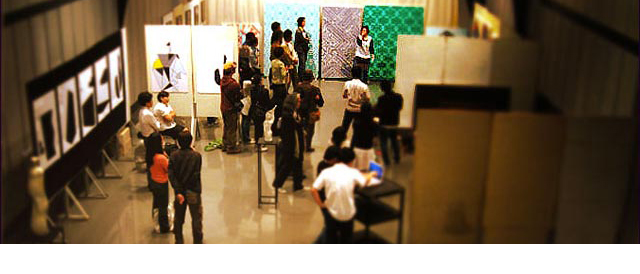Welcome to Doctoral Degree Course

The aim of the Doctoral Degree Course are the acquisition of a high degree of creative ability and certain concept, and also the cultivation of human resources who in the future are capable of occupying an instructional position through preparation involving the development of a broad range of opinions concerning the art in general.
In modern society, human resources who have broad points of view and general judgmental capacities that enable them to respond to the conspicuous development and diversification of researches as well as the rapid changes in society are being sought. In the field of art, the cultivation of human resources who can both create and theorize is being pursued. Human resources who can grasp the “depth” of fractionized individual fields and their comprehensive “breadth” are regarded as necessary by society.
In this university’s Graduate School (Master’s Degree Course) specializations are divided into 5 areas: Painting, Sculpture, Ceramic, Glass and Metal Works, Design, and Art Science; in contrast with this, these things are all synthesized into a department of art in the Doctoral Degree Course. This current state of affairs in art and design is in response to the transcending of the heretofore specialization-divided framework.
In the Doctoral Degree Course, the integration of creative art research and aesthetic theory research is planned. Creative art research involves investigation of the creation of works and the practical skills involved; Aesthetic theory research entails investigation of arts theory and history. Through the organic combination of both of those things and through the integrated acquisition of skills involving creation, knowledge, contemplation, discussion, and writing, we believe that the transition to a “higher level” can be achieved.
For the sake of the creation of works and the writing of theses with a high level of quality and content worthy of the doctoral degree, instruction is provided by first establishing how it will be done based on the student’s research theme, and then giving guidance through a collaboration of instructors of creation and instructors of theory. Furthermore, through the integrated instruction of all members of the Doctoral Degree Course instruction staff, a point of view that integrates both creation and theory will be cultivated.
The Doctoral Degree Course is constructed so that the cultivation of artists and aesthetic theoreticians who have broad perspectives and opinions can be pursued.
To those from overseas taking an examination of the course,
The Doctoral Degree Course of Tama Art University differs from ordinary doctoral courses in that it has two special aspects. This is not something that is seen overseas, so we will provide a simple explanation. One of these special aspects is the fact that the Doctoral Degree Course has a system that stands independently apart from the Master’s Degree Course. Just like the undergraduate course, the Master’s Degree Course is divided into programs such as painting, sculpture, design, and the like; however, the Doctoral Degree Course integrates everything into a single course. This is in response to the current state of affairs in the arts in which the significance of heretofore existing classification of fields has weakened; also, through debates with students and instructors from other fields, the program is designed to facilitate the research of arts from a more integrated perspective.
The other special trait is the granting of degrees through evaluation that integrates creation and theory. Therefore, theses and works shall be presented as the basis on which the degree examination is conducted. Throughout the time one is enrolled in the university, one’s theoretical research and created works will be continuously evaluated. (There are also students who only create theses centered on theoretical research.) There are multiple instructors for each student who follow these policies as they supervise theory (theses) and creation (practical skills). Also, critical work review committees and research presentations in which all instructors and students will participate will be held on a regular basis. It is an environment in which everyone can get to know one another well. We feel that as a place where one can create and discuss with artists from different fields and different cultural spheres, it is very enriched and stimulating.
These can be written in either English or Japanese. However, because we have prepared no English language lectures, please prepare Japanese language conversation ability that will facilitate communication between you and the instructors and other students.
We are waiting for you all to give it a try.
* Please refer to the FAQ for details regarding entrance exams, course fees, and the like.